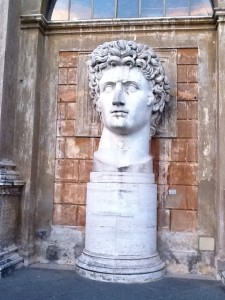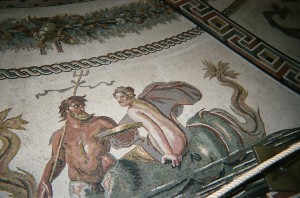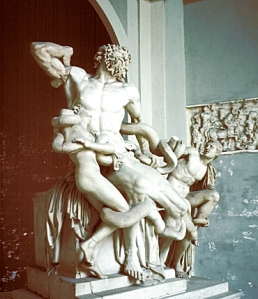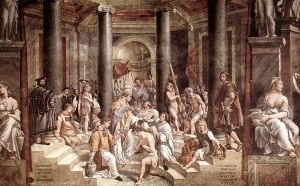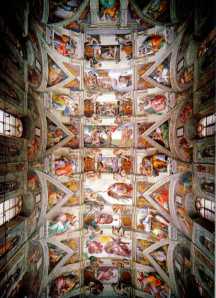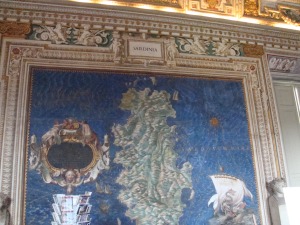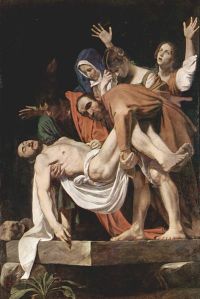I can't resist the ancient "giant head " sculptures in Rome! They truly relflect the egos that have dominated this town for centuries.
The museums contain some of the most important masterpieces of sacred Renaissance art. The intricate and elaborate Roman mosaic floors were made from tesserae colored marble.
Many Roman military leaders were commemorated with statues throughout Rome. The statues were originally painted with vibrant colors like this replica of the Prima Porta Augustus shown below. The original marble Augustus of Prima Porta is also in the museum. The statue of Augustus Caesar was discovered in 1863, in the Villa of Livia at Prima Porta, near Rome. Augustus Caesar's wife, Livia Drusilla, retired to the villa after his death. The sculpture is now displayed in the Braccio Nuovo of the Vatican Museums.

There are 54 galleries (salas) in the museums. The last one is the Sistine Chapel. You will witness one of the oldest and most comprehensive art collections in the world! Let’s take a look at some of Vatican Museum’s treasures and masterpieces.
1.Pope Julius II founded the museums in the early 16th century. They were visited by 4,310,083 people in the year 2007.
The Vatican Museums trace their origin to one marble sculpture, purchased 500 years ago; the sculpture of Laocoon.
The story of Laocoön was the subject of a play by the Greek writer Sophocles. According to Greek mythology, Laocoön was killed after attempting to expose the ruse of the Trojan Horse by striking it with a spear. The snakes were sent by Athena, and were interpreted by the Trojans as proof that the horse was a sacred object. The most famous account of these events is in Virgil's Aeneid. Laocoön warned his fellow Trojans against the wooden horse presented to the city by the Greeks. In the Aeneid, Virgil gives Laocoön the famous line Equo ne credite, Teucri / Quidquid id est, timeo Danaos et dona ferentes, or "Do not trust the Horse, Trojans: Whatever it is, I fear the Greeks even bearing gifts." This line is the source of the saying: "Beware of Greeks bearing gifts."
The statue was unearthed in 1506 near the site of the Domus Aurea of the Emperor Nero in Rome, in the vineyard of Felice De Fredis near the basilica of Santa Maria Maggiore.
Pope Julius II, an enthusiastic classicist, sent Giuliano da Sangallo and Michelangelo Buonarroti to examine the discovery. On their recommendation, the pope immediately purchased the sculpture from the vineyard owner. The pope put the sculpture of the Trojan "Laocoön and His Sons" who were named Antiphantes and Thymbraeus in the grips of a sea serpent on public display at the Vatican exactly one month after its discovery. It is believed that the scultures wre from the island of Rhodes and there names were Agesander, Athenodros and Polydorus.
2. The Stanze della Segnatura are four rooms decorated by Raphael. They formed part of the apartment situated on the second floor of the Pontifical Palace that was chosen by Julius II della Rovere (pontiff from 1503 to 1513) as his own residence and used also by his successors. The pictorial decoration was executed by Raphael and his school between 1508 and 1524. I love Raphael's "Baptism of Constantine" and the "Deliverance of Saint Peter."
Commissioned by Pope Julius II, Michelangelo painted the chapel ceiling between 1508 and 1512.
He resented the commission but the ceiling and The Last Judgement (1535–1541) is Michelangelo's crowning achievement in painting. The “Last Judgment” is located on the wall behind the main altar and was completed in 1541.
Pope Paul III commissioned Michelangelo’s “Last Judgment” (1536-1541). It represents a vortex of divine, human and diabolical bodies. Some souls are blessed and reach paradise and others are damned and cast down into an inferno.
There are information boards in the Cortile della Pigna that will help you navigate the art in the Chapel.
Check out the large Roman bronze pinecone that was once a fountain. It is positioned in front of the niche in the courtyard.

One of the primary functions of the Sistine Chapel is that it is a venue for the election of each successive pope in a conclave of the College of Cardinals. During a conclave, a chimney is installed in the roof of the chapel. The smoke from the chimney serves as a signal. If white smoke appears, it is generated by burning the ballots of the election. The white smoke signifies the election of a new pope. If a candidate receives less than a two-thirds majority, the cardinals send black smoke up the chimney. This is created by burning the ballots along with wet straw and chemical additives, therefore it signals that the election has not been successful.
4. The Gallery of the Busts (Galleria dei Busti) is where many ancient busts are displayed in the Museum of Antiquities.
5. The Map Room at the Vatican Musuems is incredible. The barrel vaulted ceiling of the “Gallery of Maps” is the hallway that leads to the former residences of the popes. The map room illustrates stories of the saints and events charted on the wall maps. It is located on the west side of the Belvedere Courtyard in the Vatican.
This magnificent hallway contains a series of painted topographical maps of Italy. The maps are based on drawings by friar and geographer Ignazio Danti. The gallery was commissioned in 1580 by Pope Gregory XIII.
It took Danti three years (1580–1583) to complete the 40 panels.
6. The Sarcophagus of Saint Helen, the mother of Constantine is located in Sala a Croce Greca. The ornate object is carved from red porphyry stone with Roman horsemen and barbarian prisoners from the 4th century.7. The Pinacoteca Vaticana was commissioned by Pope Pius IV in 1790. The collection was first housed in the Borgia Apartment, until Pope Pius XI ordered construction of a proper building. The designer was Luca Beltrami. The art gallery contains paintings by Giotto, Lippi, Leonardo da Vinci and Caravaggio including:
| 1. Giotto, “The Stefaneschi Altarpiece” |
| 2. Fra Angelico, “Madonna and Child with St. Dominic, St. Catherine and the Angels |
| 3. ”Filippo Lippi, “Coronation of the Virgin” |
| 4. Bellini, “Pieta” (1471) |
| 5. Pinturicchio, “Adoration of the Magi” (in the Borgia Apartment) |
| 6. Leonardo da Vinci, “St. Jerome” (1480) Raphael’s Oddi Altarpiece, “Crowning of the Virgin” (1503) and “The Foligno Madonna” |
| 7. Caravaggio’s, “The Deposition” shows Christ’s hand brushing againstthe tombstone.Saint John the Evangelist and Nicodemus, the Pharisee and doctor of law, struggle to support his body.The Virgin Mary and Mary Magdalene are bent toward Jesus.This painting was originally commissioned for a church in Rome but it was moved here when itwas returned from France. |
"The Vatican Museums Under the Stars" Exhibit is open from May 6-July 15 every Friday. Get your tickets on-line, get there early and proceed to the Sistine Chapel immediately. I was fortunate enough to almost have the entire Chapel to myself!!
After admiring the amazing art and sculptures collected by the papacy since the 15th century in the Vatican Museum, have a Vino con Vista by enjoying a glass of Cesanese or Montepulciano di Abruzzo wine in one of the charming neighborhood cafes like Bar Santa Anna or Pizzeria il Migliore on via Santa Anna.
Dr. EveAnn Lovero writes Italy Travel Guides. To learn more about Rome visit www.vino-con-vista.com


